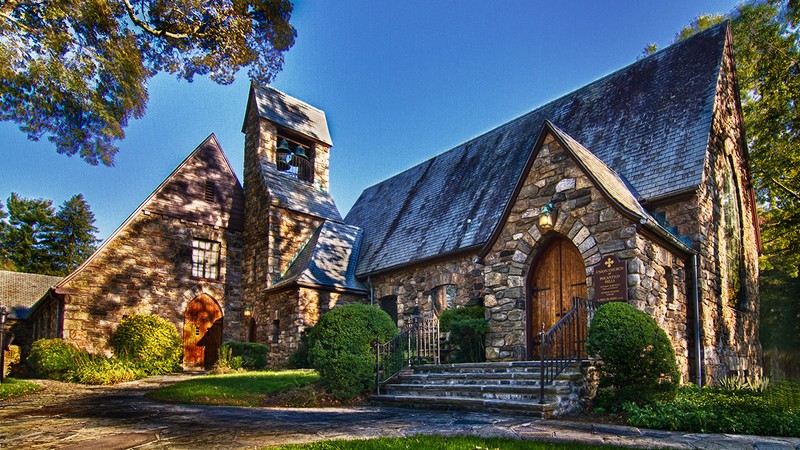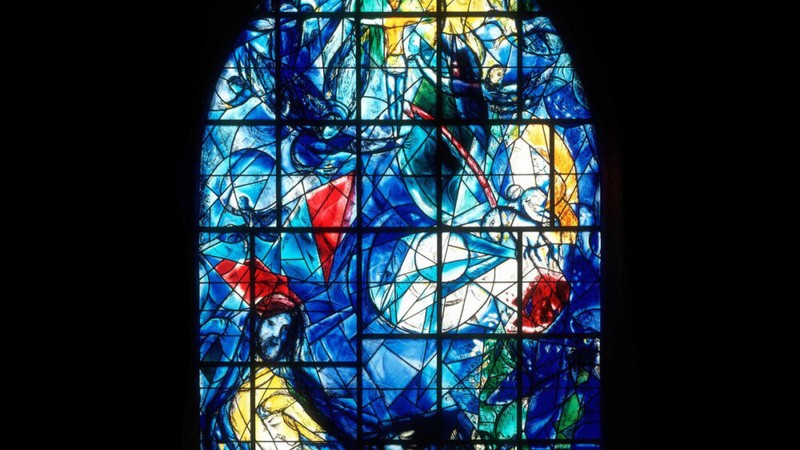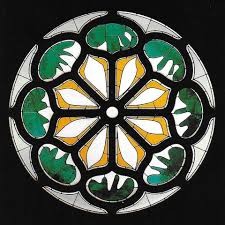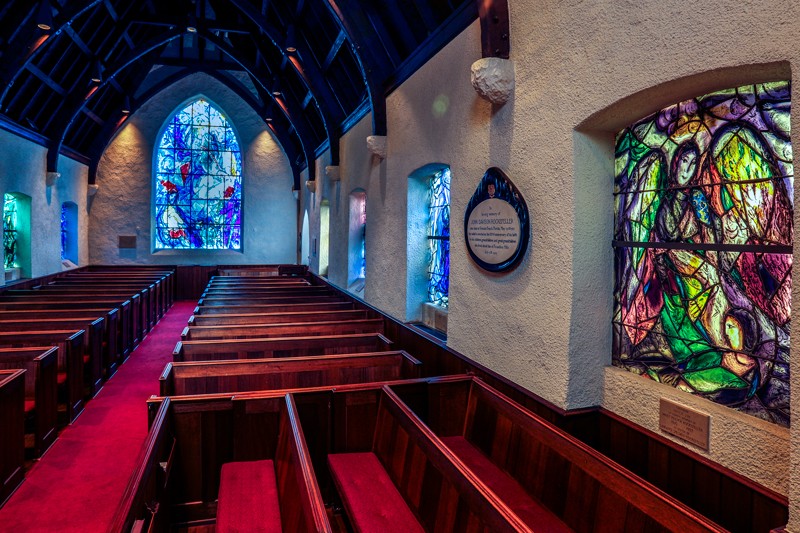Union Church of Pocantico Hills
Introduction
Text-to-speech Audio
Images
Pocantico Hills Union Church

Chagall window dedicated to John D. Rockefeller Jr.

Matisse window dedicated to Abby Rockefeller.

Interior of the church showing the collection of eight windows by Chagall.

Backstory and Context
Text-to-speech Audio
The Union Church is a single story, late gothic revival building with a fieldstone foundation and walls.[1] The main entrance to the building has complementary gothic styled arched wood doors and is a simple example of late 19th and early 20th century Gothic Revival architecture. The interior of the church is equally humble. Upon entering the vestibule, the center aisle is flanked by standard pews and the ceiling of the church is open to the roof with arched shaped rafters. Union Church was designed to be free of sectarian associations in order to serve as a religious building for the employees of the Rockefeller’s Kykuit estate.[2]
The first embellishment in the Union Church was an abstractly designed flower glass window by the great modern artist Henri Matisse. Matisse was commissioned to design the window as a memorial for the late Abby Rockefeller. Abby Rockefeller, the wife of John D. Rockefeller Jr., had a great appreciation for modern art and served as one of the three founders of the Museum of Modern Art in New York City. Citing his deteriorating health, Matisse was reluctant at first to take the commission, however, he eventually agreed. While he was too weak to stand at an easel to draw and design the window, he used the art technique of papier découpé. Matisse was able to cut the paper and arrange it into a model design of what would eventually become the window in the Union Church. Matisse died in 1954 and would not see the window be installed into the church. It is believed that the window memorial for Abby Rockefeller was his last project because the maquette was on the wall of his bedroom at the time of his death.[3]
The window designed by Matisse alone transformed the simple church into one of artistic significance however, in 1964 the Union Church would be graced with the first of a collection of nine windows by the renowned artist Marc Chagall. John D. Rockefeller Jr. died in 1960,and members of the Rockefeller family had a window commissioned in his memory. Marc Chagall was already famous for his work in stained glass, however, he would go on to only create three sets of windows for churches—one set in Zurich, one in Jerusalem, and the last at Pocantico Hills.[4] The largest of the Chagall windows—the one that was dedicated to John D. Rockefeller Jr.—depicts a dreamlike rendition of the parable of the Good Samaritan. It is a large arched window that overtakes the narthex end of the nave.[5] After the Rockefeller Jr. window was finished, Chagall began preparations for eight other windows that would be installed along the church’s nave. These windows were installed in 1966 and depict old testament subjects such as the six prophets and an image of the crucifixion which was in memory of Michael Clark Rockefeller—the son of former Vice President Nelson Rockefeller—who was lost during an anthropological expedition.[6]
The Union Church started as a very simply designed building, however, the windows by Chagall and Matisse transformed the church into an artistic shrine of vibrant colors. Being one of three sets of Chagall windows in the world in conjunction with the final artistic work by Matisse, the church attracts a large number of tourists from all around the world. Today, the church is run by the Historic Hudson Valley which is in charge of public access to the church. The Historic Hudson Valley is also in charge of Kykuit. Despite the church attraction to tourism, it is still home to an active congregation that continues to invite people from all christian denominations and “all are welcome to worship God”.[7]
Cite This Entry
Davis, Barbara and Brendan Murphy on behalf of Westchester County Historical Society. "Union Church of Pocantico Hills." Clio: Your Guide to History. September 24, 2020. Accessed April 6, 2025. https://theclio.com/tour/1530/16
Sources
[1]National Register of Historic Places Registration Form, “Union Church of Pocantico Hills”, March 9, 2002.
[2]Gray Williams, “Picturing Our Past: National Register Sites in Westchester County” (Elmsford, New York: Westchester County Historical Society, 2003), 452.
[3]National Register of Historic Places Registration Form, “Union Church of Pocantico Hills”, March 9, 2002.
[4]“Stained Glass Program Slated”, Gannett Westchester Newspapers, November 18, 1978, Westchester County Historical Society Archives, accessed August 5, 2020.
[5]Williams, 453.
[6]“Nine Windows by Chagall”, The Museum of Modern Art, New York, Westchester County Historical Society Archive, April 13-May 30, 1978, Accessed August 15, 2020.
[7]The Rev. Dr. F. Paul DeHoff, “A Service in Celebration of the Life of Helen Bang-Jensen: June 6, 1914—January 21, 2002”, The Union Church of Pocantico Hills, published March 23. 2002, accessed from the Westchester County Historical Society Archive August 15, 2020.
https://hudsonvalley.org/historic-sites/union-church-of-pocantico-hills/
https://hudsonvalley.org/historic-sites/union-church-of-pocantico-hills/
https://www.facebook.com/UnionChurchPH/
https://westchestermagazine.com/things-to-do/arts-culture/houses-of-worship-photo-gallery/

